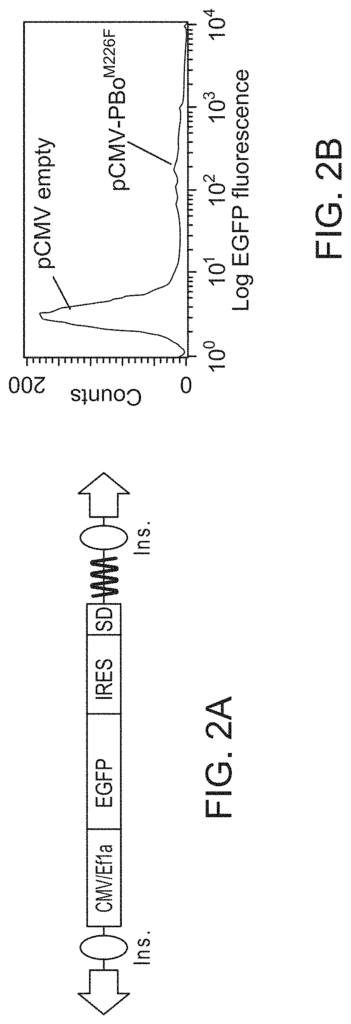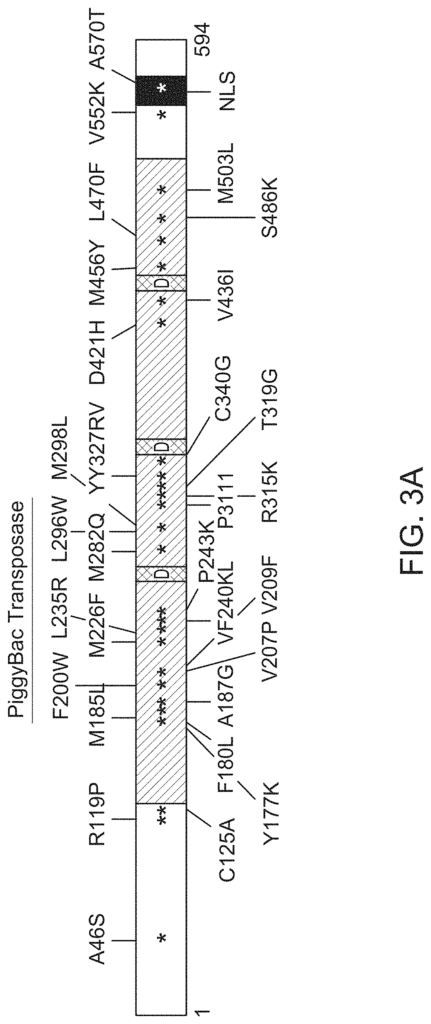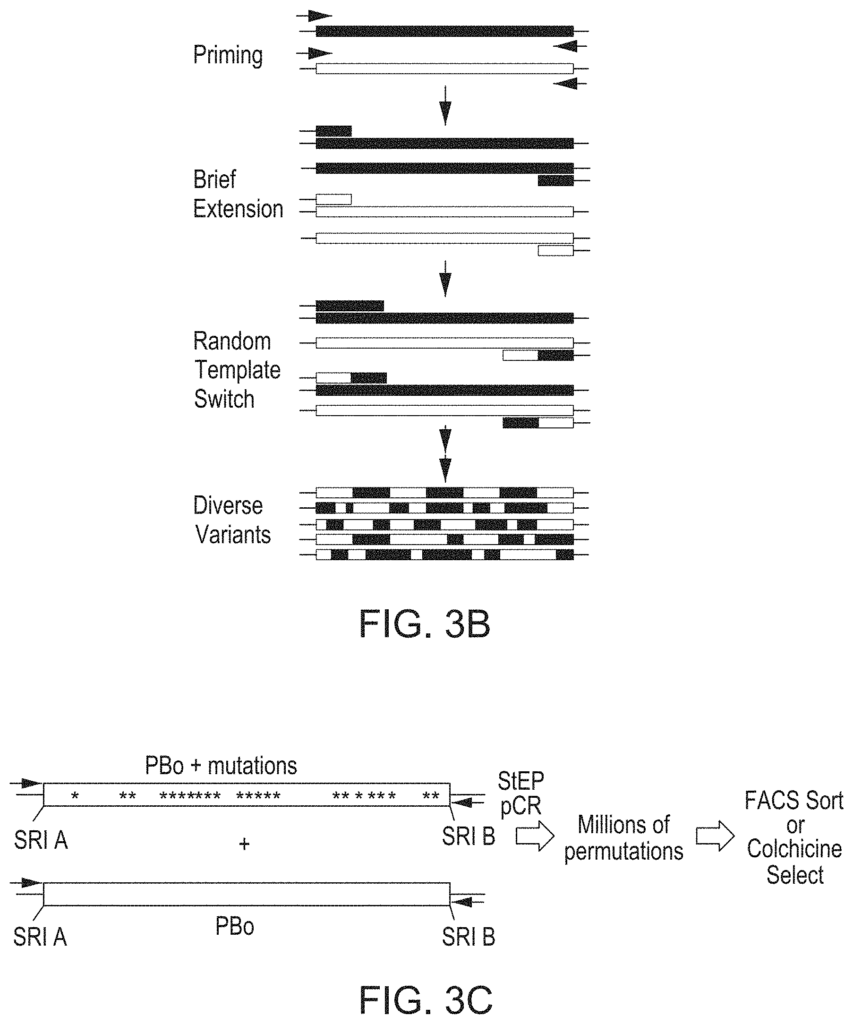Invented by Eric M. Ostertag, Blair Madison, Poseida Therapeutics Inc
One of the key advantages of hyperactive piggyBac transposases is their ability to deliver large DNA fragments into the genome of target cells. This makes them particularly useful in gene therapy, where the delivery of therapeutic genes into specific cells is crucial. Compared to other gene delivery methods, such as viral vectors, piggyBac transposases offer a safer and more efficient alternative. They can integrate the desired DNA sequences into the genome without causing significant disruptions or inducing immune responses, which are common concerns with viral vectors.
Moreover, hyperactive piggyBac transposases have shown promise in genetic engineering applications. They can be used to introduce or remove specific genes in a precise manner, allowing researchers to study gene function and develop genetically modified organisms with desired traits. This has significant implications in agriculture, where the ability to engineer crops for improved yield, resistance to pests or diseases, and enhanced nutritional content can revolutionize food production.
In the field of drug discovery, hyperactive piggyBac transposases offer a valuable tool for understanding the mechanisms of diseases and developing novel therapeutics. By introducing disease-associated genes into animal models, researchers can study the effects of these genes on disease progression and test potential drug candidates. This approach enables the identification of new drug targets and the development of personalized medicine, tailored to individual patients’ genetic makeup.
The market for hyperactive piggyBac transposases is driven by the increasing demand for efficient and precise gene delivery systems. The global gene therapy market is projected to reach billions of dollars in the coming years, and piggyBac transposases are well-positioned to capture a significant share of this market. Additionally, the growing interest in genetic engineering and drug discovery further fuels the demand for these enzymes.
Several companies are actively involved in the development and commercialization of hyperactive piggyBac transposases. They offer a range of products, including plasmids encoding the transposase enzyme, transposon vectors for gene delivery, and custom services for specific research needs. These companies are continuously improving the efficiency and safety of piggyBac transposases, ensuring their widespread adoption in various applications.
In conclusion, the market for hyperactive piggyBac transposases is expanding rapidly due to their unique capabilities in gene therapy, genetic engineering, and drug discovery. With their ability to deliver large DNA fragments, precise gene editing, and safe integration into the genome, these enzymes hold immense potential for revolutionizing various industries. As research and development efforts continue to enhance their efficiency and versatility, hyperactive piggyBac transposases are poised to become indispensable tools in the advancement of science and medicine.

The Poseida Therapeutics Inc invention works as follows
The present invention provides PiggyBac Transposase Proteins, Nucleic Acids encoding them, compositions containing the same; kits containing the same; non-human transgenic animal containing the same and methods for using them.

Background for Hyperactive Piggybac Transposases
The PiggyBac transposase is a functional protein that plays a role in the excision and reintegration of PB transposons (Fraser et. al., Insect Molecular Biology, 1996, 5, 141-51; Mitra et.al., EMBO J., 2008, 27, 1097-1109; and Ding et.al., Cell, 2005, 122, 473-473). Biol., 1996, 5, 141-51; Mitra et al., EMBO J., 2008, 27, 1097-1109; and Ding et al., Cell, 2005, 122, 473-83). In some cases, it is desirable to increase the movement of a transposon from one part of the DNA to another. In order to choose a hyperactive ttransposase one should select a transposase which can move a transposon quickly and efficiently from one genomic site to another. For a given experimental period, it would be desirable to use a hyperactive compared to a non-hyperactive tranposase in order for the cell integrations of transposonsons to be higher. Herein are provided hyperactive PiggyBac Transposase Proteins, nucleic acid encoding them, compositions containing the same kit containing the same non-human transgenic animal incorporating the same and methods to use the same.
The
In certain embodiments, the proteins have at least 80% of the sequence identity with SEQ NO: 2. They also contain at least one amino acid substitution in SEQ NO: 2: serine for glycine; leucine or phenylalanine; valine; glutamine; tryptophan; leucine; leucine; valine; proline; valine; proline; valine; isole
In some embodiments the protein contains at least 80% of sequence identity with SEQ NO: 2 and includes at least one amino acid substitution in SEQ NO: 2. In some embodiments the protein contains at least 90% of SEQ NO: 2 sequence identity and at least one amino acid substitution in SEQ NO: 2. In some embodiments the protein has at least 95% of sequence identity with SEQ NO: 2 and contains at least one amino acid substitution in SEQ NO: 2. In some embodiments the protein contains at least 95% sequence identity to SEQ NO: 2. It also includes at least one amino acid substitution in SEQ NO: 2.
In some embodiments the protein has at least 80% identity in sequence to SEQ NO: 2 and includes more than one amino acid substitution. In some embodiments the protein contains at least 90% of SEQ NO: 2 sequence identity and includes more than one amino acid substitution in SEQ NO: 2. In some embodiments the protein has at least 95% of sequence identity with SEQ NO: 2 and contains more than one amino acid substitution in SEQ NO: 2. In some embodiments the protein contains at least 99% of sequence identity with SEQ NO: 2 and includes more than one amino acid substitution in SEQ NO: 2. In some embodiments the protein contains SEQ NO. 4, SEQ NO. 6, SEQ NO. 8, SEQ NO. 10, SEQ NO. 12, SEQ NO. 14, SEQ NO. 16, SEQ NO. 18, SEQ NO. 20, SEQ
In certain embodiments, the proteins include SEQ NO. 24, SEQ NO. 26, SEQ NO. 28, SEQ NO. 30, SEQ NO. 34,SEQ NO. 38,SEQ NO. 40,SEQ NO. 44,SEQ NO. 46,SEQ NO. 48,SEQ NO. 50,SEQ NO. 52,SEQ NO. 54,SEQ NO. 56,SEQ NO. 58,SEQ NO. 62,SEQ NO. 76,SEQ NO
The In In
The present invention provides vectors that contain any of these nucleic acid described above and encode any of these proteins described above. In some embodiments the vector is called a plasmid. In some embodiments the vector is a plasmid. In some embodiments the retrovirus includes long terminal repeats as well as a psi packing signal, a site for cloning, and a marker sequence. The present invention provides cells that contain any of the vectors or nucleic acid described herein. In certain embodiments, the sperm cell or egg is used.
The present invention also provides kits that include: a vector containing a nucleic acids encoding one of the proteins described in this document; and a insertion site for a exogenous nucleic acids, flanked by either a first repeat inverted sequence containing a sequence with at least 90% sequence similarity to SEQ NO: 91 or a second repeat inverted sequence containing a sequence with at least 90% sequence similarity to SEQ NO:92.
The present invention provides also non-human transgenic animals that contain a nucleic acids molecule encoding one or more of the described proteins. In some embodiments the non-human transgenic animal also comprises a transposon that includes an insertion sequence for an exogenous RNA, wherein the transposon is flanked with a first repeat sequence with a sequence having at least 90% sequence similarity to SEQ NO: 91, and/or by a second repeat sequence with a same sequence as SEQ NO:92.

The present invention also provides methods for integrating an exogenous RNA into the genomes of at least one multicellular or monocellular organism. These include administering directly to a multicellular/unicellular organism a transposon containing the exogenous RNA, wherein said exogenous RNA is flanked with a first repeat sequence having a sequence that shares at least 90% of its sequence identity with SEQ NO: 91, and/or by a second repeat sequence having a similar sequence to SEQ NO: 92 and/or In some embodiments the protein is administered in the form of a nucleic acids encoding it. In some embodiments the transposon is present on a separate vector from the nucleic acids encoding the proteins. In some embodiments the transposon encoding the gene and the nucleic acids are on the same vector. In certain embodiments, the organism can be multicellular or monocellular. In certain embodiments, a vertebrate is a mammal. In some embodiments the administering occurs systemically. In certain embodiments, exogenous nucleic acids are a gene.
The present invention also provides methods for generating a transgenic non-human animal that contains a germline mutant. These include: breeding a first transgenic non-human animal that includes a transposon, with a second transgenic non-human animal that includes a vector containing a nucleotide code encoding one of the proteins described in this document.
The present invention provides also methods for generating a nonhuman, transgenic animals. These include: introducing into a cell a nucleic-acid molecule that encodes any of the described proteins under conditions sufficient to produce a transgenic organism.

Click here to view the patent on Google Patents.

Leave a Reply